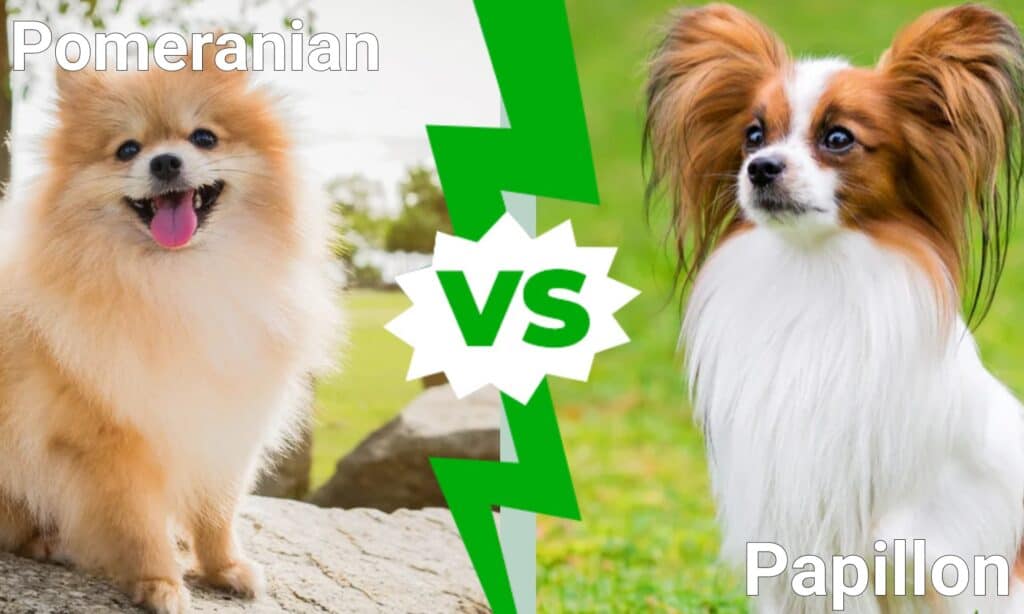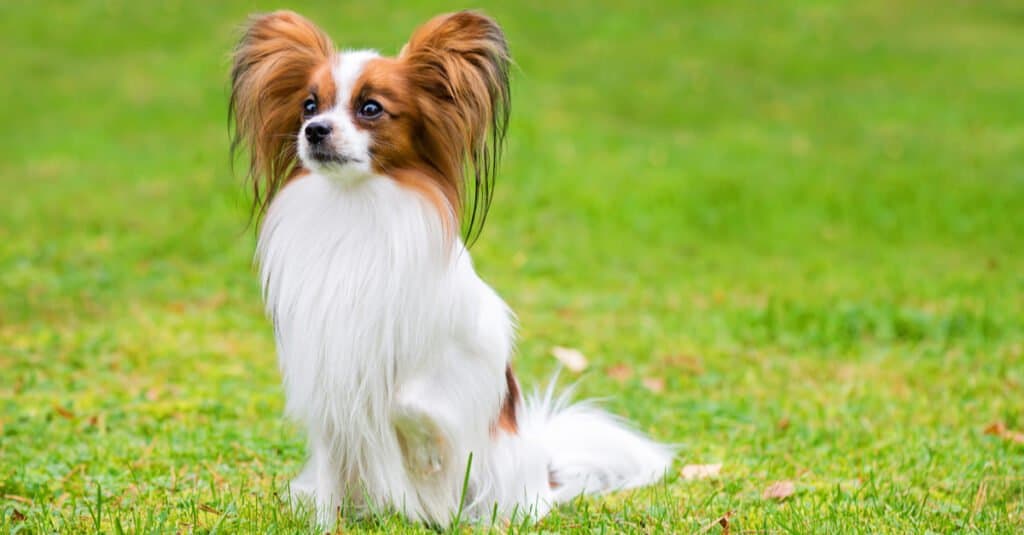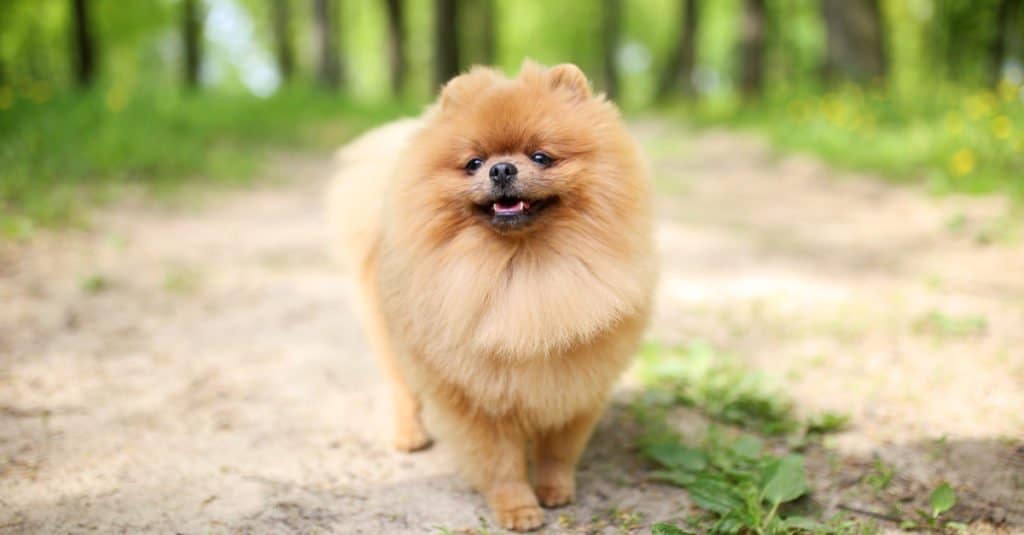Pomeranians and Papillons are both very small, but adorable dogs classed as toy dogs because of their small stature. They are firm favorites, and they make excellent companion dogs. They have a lot of similarities, and it can be easy to confuse the two if you’re unfamiliar with them. But don’t worry, as when it comes to Pomeranian vs Papillon, there are some key differences that we can use to tell the two apart.
In this article, we’ll discuss everything you need to know about Pomeranians and Papillons. We’ll discuss their appearance – including their color, coat type, and the shape of their ears. We’ll also discuss their behavior and energy levels and discover where these breeds originated. So, join us as we discover all the differences between Pomeranians and Papillons.
Comparing Papillons and Pomeranians

Pomeranians and Papillons are both intelligent and active little dogs. Although they both enjoy the comfort of a house, they are active despite their small size. Although Pomeranians are best known for their thick and fluffy coats, they both have impressive coats. But that’s not all, so check out the chart below to compare the two breeds.
| Papillon | Pomeranian | |
| Origin | France | Germany and Poland |
| Other Names | Continental toy spaniel, butterfly dog, squirrel dog | Pom, Dwarf Spitz, Deutscher Spitz |
| Size | Weight – 5 to 10 pounds Height – 8 to 11 inches | Weight – 3 to 7 pounds Height – 7 to 12 inches |
| Color | Typically white with either black, red, or brown | Varies widely, but common colors are black, white, tan, and orange |
| Coat | Single coat | Double coat |
| Ears | Large, upright, fringed with long hair | Small and triangle-shaped |
| Appearance | Short and thin muzzle, petite body, tail covered with long hair and carried over back | Fox-like face, sturdy body, plumed tail carried high over the back |
| Behavior | Intelligent, sociable, energetic, affectionate | Friendly, playful, active, intelligent |
| Lifespan | 13 – 15 years | 12 – 16 years |
The 5 Key Differences Between Pomeranians and Papillons

Papillons are best known for the long hair that fringes their ears.
©AndyBir/Shutterstock.com
The main differences between Pomeranians and Papillons are color, behavior, appearance, size of ears, and coat type. Pomeranians have a thick and fluffy double coat, while Papillons have a smooth and flowing single coat. Papillons also have ears that are extremely distinctive because of the long hair which flows from them. Although both are generally very good-natured, Pomeranians can be slightly more dominant and demand attention from their owners.
Let’s discuss these differences in detail.
Pomeranian vs Papillon: Coat
One of the most noticeable differences between Papillons and Pomeranians is their coats. Pomeranians have a double coat consisting of a short but incredibly thick and soft undercoat and a much longer outer coat. The hair on the outer coat is long and straight but not as soft as the undercoat. Pomeranians shed their undercoat twice a year which can cause the outer coat to become more tangled than usual. Therefore, they require regular grooming to keep their coat in top condition and free from knots. Additionally, the outer layer usually forms a thick mane or a distinctive ruff at the back of their neck.
Papillons have only a single coat that is soft and silky. Although they also shed twice a year, it is only moderate and often isn’t particularly noticeable.
Pomeranian vs Papillon: Color
Papillons are typically white with patches of any color. However, white with black, red, brown, or lemon is the most common. A white blaze (strip of white extending down the forehead and between the eyes) is the preferred marking for the breed over a completely solid-colored head.
Although the earliest Pomeranians were black, white, or brown, nowadays, they have one of the widest varieties of colors of any dog breed. However, common colors are black, white, tan, and orange.
Pomeranian vs Papillon: Ears

Papillons have much larger ears than Pomeranians.
©Anna Maloverjan/Shutterstock.com
One of the most iconic aspects of a Papillon is its ears. Papillons have large ears for the size of dog that they are. They stand upright and are fringed with long, flowing hair, which gives the appearance of a butterfly wing. This is also why another name for Papillons is the “butterfly dog.”
Pomeranians have small ears which are triangle-shaped. They are noticeably pointed and stand upright.
Pomeranian vs Papillon: Appearance
Most Pomeranians have a fox-like face with a defined snout. However, their heads often have a rounded appearance with their thick hair. Pomeranians have sturdy bodies, and a thick, plumed tail carried high over their back.
Papillons have a much more petite appearance than Pomeranians. Their muzzle is short and thin, and their face has a much more defined appearance as they lack the abundance of hair around it that Pomeranians have. However, Papillons also have a tail covered in long hair and carried over their back which is why they are sometimes called squirrel dogs.
Pomeranian vs Papillon: Behavior

Pomeranians like to be active, but they can be defensive of their territory and dominant at times.
©KristinaSh/Shutterstock.com
Papillons are friendly and energetic dogs. They are very sociable and affectionate towards people they know but can be wary of people they don’t know. This also makes them excellent watchdogs, and they regularly alert their owners to anything they consider suspicious or out of place. Although they are excellent companion dogs, Papillons have quite a high energy level, making them equally well suited to active homes.
Pomeranians are friendly and playful dogs. However, they can be defensive of their territory and often bark at noises they hear outside. They are also very intelligent dogs and are very good at getting what they want, which can sometimes lead to them becoming dominant.
The photo featured at the top of this post is © iStock.com/FaST_9
Ready to discover the top 10 cutest dog breeds in the entire world?
How about the fastest dogs, the largest dogs and those that are -- quite frankly -- just the kindest dogs on the planet? Each day, AZ Animals sends out lists just like this to our thousands of email subscribers. And the best part? It's FREE. Join today by entering your email below.
FAQs (Frequently Asked Questions)
Are pomeranians and papillons good with other pets?
So long as they are properly socialized from a young age most papillons are well behaved around other pets, including other dogs. However, pomeranians can be aggressive towards other dogs when are defending their territory or trying to show dominance.
Where did pomeranians and papillons originate?
Pomeranians are descended from larger Spitz type dogs – such as the German Spitz. Pomeranians are favorites amongst royals and they became increasingly popular due to Queen Victoria owning several during her reign. She also had her own breeding program of pomeranians and worked to promote and improve the breed.
Not a lot is known about the history of the papillon breed, but they are thought to have originated in France more than 600 years ago. Traditionally, they are considered to be a type of spaniel, which is why they are sometimes called continental toy spaniels.
Thank you for reading! Have some feedback for us? Contact the AZ Animals editorial team.






